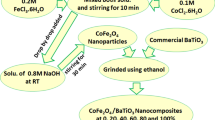Abstract—We have synthesized needle- and platelike α-Bi2O3 and Bi2O2CO3 nanoparticles. The bulk density of the α-Bi2O3 and Bi2O2CO3 powders is 8.5 and 6.9 g/cm3. The dielectric permittivity of α-Bi2O3 and Bi2O2CO3 has been calculated using dielectric permittivity and dielectric loss tangent dispersion measurements in the frequency range from 2.5 × 101 to 1 × 106 Hz for 40% suspensions (0.05 and 0.08 volume fractions of α-Bi2O3 and Bi2O2CO3, respectively) in PMS-300 polydimethylsiloxane. The value of ε∞ has been found to be 5.4 for α-Bi2O3 and 4.9 for Bi2O2CO3. Dielectric spectra of the suspensions have been shown to exhibit no relaxation behavior in the frequency range studied. We have compared the effects of the shape and dielectric permittivity of the particles on the magnitude of the electrorheological effect in them. Using a simple polarization model, we have analyzed the effect of the dielectric characteristics of the filler material on the yield stress τ0 of the suspensions in electric fields from 0 to 4 kV/mm. Using a combination of rheometric and direct microscopic observations, we have explained the effect of the type of filler on the electrorheological effect: the Bi2O2CO3-based ERFs have higher shear and compressive yield stresses, whereas the α-Bi2O3-based ERFs have a higher tensile yield stress.












Similar content being viewed by others
REFERENCES
Agafonov, A.V. and Zakharov, A.G., Electrorheological fluids, Russ. J. Gen. Chem., 2010, vol. 80, no. 3, pp. 567–575.
Winslow, W.M., Induced fibration of suspensions, J. Appl. Phys., 1949, vol. 20, no. 12, pp. 1137–1140.
Marshall, L., Zukoski, C.F., and Goodwin, J.W., Effects of electric fields on the rheology of non-aqueous concentrated suspensions, J. Chem. Soc., Faraday Trans. 1, 1989, vol. 85, no. 9, pp. 2785–2795.
Lykov, A.V., Shul’man, Z.P., and Deinega, Yu.F., Elektroreologicheskii effekt (Electrorheological Effect), Minsk: Nauka i Tekhnika, 1972.
Heyes, D.M. and Melrose, J.R., Brownian dynamics simulations of electrorheological fluids, II, Mol. Simul., 1990, vol. 5, no. 5, pp. 293–306.
Mokeev, A.A. and Mokeev, A.A., An equation of motion of an electrorheological suspension, Mekh. Kompoz. Mater. Konstruktsii, 2000, vol. 6, no. 1, pp. 117–140.
Bonnecaze, R.T. and Brady, J.F., Dynamic simulation of an electrorheological fluid, J. Chem. Phys., 1992, vol. 96, no. 3, pp. 2183–2202.
Martin, J.E. and Anderson, R.A., Chain model of electrorheology, J. Chem. Phys., 1996, vol. 104, no. 12, pp. 4814–4827.
Tao, R. and Jiang, Q., Simulation of structure formation in an electrorheological fluid, Phys. Rev. Lett., 1994, vol. 73, no. 1, pp. 205–208.
Yanovskii, Yu.G. et al., Electrorheological fluids: theoretical and experimental approaches to describing them, Fiz. Mezomekh., 2003, vol. 6, no. 6, pp. 61–69.
Lu, J. and Zhao, X., Electrorheological properties of suspensions based on polyaniline–montmorillonite clay nanocomposite, J. Mater. Res., 2002, vol. 17, no. 6, pp. 1513–1519.
Kim, S. et al., Electrorheological characteristics of phosphate cellulose-based suspensions, Polymer, 2001, vol. 42, no. 11, pp. 5005–5012.
Kim, S.G. et al., Viscoelastic characterization of semiconducting dodecylbenzenesulfonic acid doped polyaniline electrorheological suspensions, J. Appl. Polym. Sci., 2001, vol. 79, no. 1, pp. 108–114.
Zhao, X.P. and Duan, X., In situ sol–gel preparation of polysaccharide/titanium oxide hybrid colloids and their electrorheological effect, J. Colloid Interface Sci., 2002, vol. 251, no. 2, pp. 376–380.
Agafonov, A.V. et al., Nanocrystalline ceria: a novel material for electrorheological fluids, RSC Adv., 2016, vol. 6, no. 91, pp. 88 851–88 858.
Liu, Y.D. et al., Fabrication of semiconducting polyaniline/nano-silica nanocomposite particles and their enhanced electrorheological and dielectric characteristics, Colloids Surf., A, 2011, vol. 381, nos. 1–3, pp. 17–22.
Yukhin, Yu.M. and Mikhailov, Yu.I., Khimiya vismutovykh soedinenii i materialov (The Chemistry of Bismuth Compounds and Materials), Novosibirsk: Sib. Otd. Ross. Akad. Nauk, 2001.
Egorysheva, A.V. et al., Targeted synthesis ultrafine α- and γ-Bi2O3 having different morphologies, Russ. J. Inorg. Chem., 2017, vol. 62, no. 11, pp. 1426–1434.
ACKNOWLEDGMENTS
This work was supported by the Russian Science Foundation, grant no. 16-13-10399. In our research, we used equipment at the Shared Physical Characterization Facilities Center, Kurnakov Institute of General and Inorganic Chemistry, Russian Academy of Sciences.
Author information
Authors and Affiliations
Corresponding author
Rights and permissions
About this article
Cite this article
Egorysheva, A.V., Kraev, A.S., Gaitko, O.M. et al. Electrorheological Properties of α-Bi2O3 and Bi2O2CO3. Inorg Mater 55, 344–354 (2019). https://doi.org/10.1134/S0020168519030075
Received:
Revised:
Accepted:
Published:
Issue Date:
DOI: https://doi.org/10.1134/S0020168519030075




